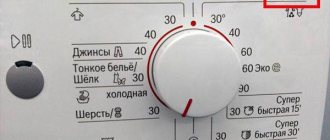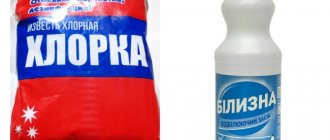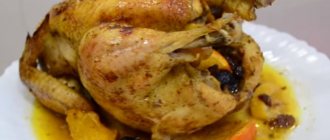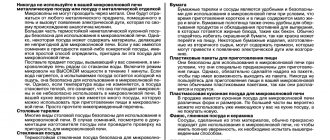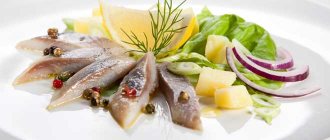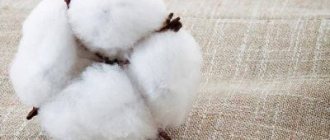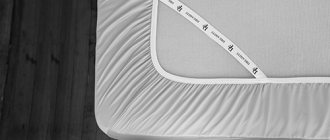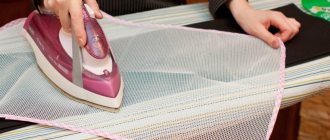In order for clothes to retain their original appearance for a long time, they must not only be properly washed and dried, but also ironed. In ancient times, housewives smoothed things out using a stone or roller heated in a flame, and there was practically no risk of ruining the fabric. Then irons appeared, heated with coal, which took root in everyday life for a long time. And only many years later the first electric iron was invented - a very convenient device that requires great care and precision in handling.
Read in this article:
- What you need to know about ironing temperature
- Icons on labels - what do they mean?
- Wool ironing temperature
- Ironing silk items
- Ironing linen and cotton
- Tips for ironing synthetics
- What items cannot be ironed?
Ironing temperature for fabrics – what should you consider?
At what temperature should you iron cotton and other fabrics? Today you can find smart equipment on sale that has many different functions, greatly simplifying the ironing process. You just need to set the desired mode according to the type of fabric and the iron will set the temperature itself. But in any case, you need to be careful - even if you lose vigilance for a short time when ironing clothes, the housewife can ruin a beautiful new thing.
But, in addition to following the instructions included with the iron, you need to pay attention to the ironing marks on the clothes. The characteristics of modern fabrics are almost impossible to determine by touch: without looking at the label, you can confuse cotton with synthetics. Fabric with the addition of synthetic threads, ironed with an iron whose temperature is set to work with a cotton item, will be hopelessly damaged.
Good to know
What to do if you don’t have an iron at hand and you urgently need to go to a business meeting? Our article will tell you how you can iron things without an iron as quickly and safely as possible for the fabric.
Chiffon is a very delicate material that requires the most careful handling. That is why we decided to tell you how to iron chiffon so as not to burn or spoil the fabric.
Features of heating irons
Every housewife knows that a good iron should have the following qualities:
- uniform heating of the sole;
- moderate weight;
- smooth glide.
It is very important that the set temperature for ironing fabrics on the device is maintained evenly over the entire surface of the sole. This indicator largely depends on the material of manufacture. For these purposes the following are used:
- ceramics;
- aluminum;
- steel;
- cast iron.
Ceramics have proven themselves best. The temperature maximum occurs in the center of the sole, gradually decreasing towards the edge. The approximate difference between the center and the outskirts is about 10 °C.
We recommend: Washing cotton in a washing machine and by hand
Most devices have in their design such components as a heating element, thermostat, signal lamp and steam function.
Each iron operating mode has 3 temperature values: nominal, maximum and minimum. The data is presented in the table.
Table 1. Iron sole temperature values for different modes
| • | •• | ••• | |
| Maximum value, °С | 115 | 155 | 205 |
| Minimum, °С | 75 | 105 | 145 |
| Nominal, °С | 95 | 130 | 175 |
What do the icons on the labels mean?
How to care for the item can be seen on the label. In addition to instructions regarding washing and drying, the labels contain ironing icons in the form of an iron in different designs:
| the icon indicates that the material can be processed with an iron, including using the machine ironing function; |
| the fabric is processed with an iron heated to 200 degrees, a similar designation is usually found on linen and cotton products; |
| The ironing temperature should not exceed 140 degrees; if there is no marking on the iron, then the slider is set to approximately the middle; |
| fabric can be ironed at 130 degrees, no higher, as a rule, these are items made of wool, viscose, polyester, polyester, silk; |
| the iron should be slightly heated, no more than 120 degrees - a mode used for working with delicate fabrics that require accuracy and caution; |
| The do not iron icon means that the item cannot not only be ironed, but also steamed; |
| If you see such a sign, you must turn off the steam function on the iron: the item cannot be steamed. |
The listed symbols for ironing clothes help set the temperature setting on the iron appropriate for a specific type of fabric.
It is important to know: it is better to start ironing with a low temperature, gradually bringing it to the maximum value.
Recently, many iron manufacturers have made it easier for housewives to choose the temperature setting. The instrument relays are marked not with a degree scale, but with letter designations: “wool”, “nylon”, “cotton” and so on. Before ironing the item, you should test the temperature on a piece of fabric (patch), which is usually located next to the label. If the fabric does not stick to the sole, then you can start ironing.
But it happens that the item is not equipped with a label with care instructions or the label was lost during wear. In this case, how can you determine at what temperature to iron the product? Let's try to figure it out.
Ironing
Ironing is one of the most important and necessary steps in caring for fabric and products. With proper ironing or steaming, you can delay the next cleaning. For example, this applies to products made from suit wool and coats. Steaming in this case raises the pile (or micropile) and partially removes contaminants from the fabric structure, and cleaning occurs. If the fabric has a voluminous texture or volume (for example, knitted jersey), you need to iron it without pressure or even at a distance of 2-3 centimeters from the surface. This applies to any type of fabric. Always iron fabrics in one layer. A great way is to use a vertical steamer. Hang the product/fabric on a mannequin or hanger and use a steamer. If you steam a product at home, without special tailoring equipment (pads), and you need to steam hard-to-reach places (for example, the side under a sleeve, etc.) and small parts (for example, pocket flaps, places of relief darts, etc.), use a special heat-resistant glove. They are sold in hardware and sewing stores and are very convenient to use. If the fabric is embroidered with beads, sequins, beads, etc. - use a steamer. Use steam at a distance of several centimeters so that the folds on the base are straightened out, but the beads and sequins, especially plastic ones, do not melt. Yes, this can really happen) Another important note regarding embroidered fabrics - glass beads and seed beads can scratch the surface of the iron.
At what temperature should you iron wool?
The temperature for ironing wool is 180 degrees. The material needs moisture even more than cotton fabric. The disadvantage of high-quality and expensive woolen items is that they are prone to rapid deformation and loss of shape. Lack of proper care leads to compression or stretching of the material. Therefore, iron them inside out using a cloth soaked in water, preventing the iron from sliding on the fabric.
It is important to know: information on ironing woolen items can be found in the instructions for the iron; the main thing is not to forget that only woven woolen clothing can be ironed. Knitted items should not be ironed as they may stretch and lose their shape.
Features of heating irons
Every housewife knows that a good iron should have the following qualities:
- uniform heating of the sole;
- moderate weight;
- smooth glide.
It is very important that the set temperature for ironing fabrics on the device is maintained evenly over the entire surface of the sole. This indicator largely depends on the material of manufacture. For these purposes the following are used:
- ceramics;
- aluminum;
- steel;
- cast iron.
Ceramics have proven themselves best. The temperature maximum occurs in the center of the sole, gradually decreasing towards the edge. The approximate difference between the center and the outskirts is about 10 °C.
Most devices have in their design such components as a heating element, thermostat, signal lamp and steam function.
Each iron operating mode has 3 temperature values: nominal, maximum and minimum. The data is presented in the table.
This excerpt (second) is taken from the article: https://domashniy.net/dom-i-byt/garderob/temperatura-glazhki-tkanej.html
Methods for ironing silk fabrics
Silk should be ironed from the inside out, after placing a thin damp cloth (for example, gauze) on top. The temperature for ironing silk does not exceed 160 degrees. Silk products require special attention when processing with a hot iron:
- a little overkill with the temperature or stopping in one place during the ironing process leads to the formation of scorch marks;
- treatment with steam or water from a spray bottle may cause stains to appear on the product.
Silk is ironed while wet, not allowing the product to dry after washing or after holding it in a wet rag or towel.
Good to know
To iron silk products without leaving stains or marks, you need to know exactly not only the ironing temperature. There are other ways to remove wrinkles without using an iron.
Tulle is also made from various delicate materials, which is why it is so important to know how to iron tulle so as not to spoil anything. Here you will find the most useful tips for yourself - let's study them.
Wool
What is the material - wool?
Why are products made from natural wool considered one of the most expensive? What is wool fabric and how did it come about? The designation “wool” is used to refer to a whole group of textile materials; in the process of their production, the natural hair of the animal is usually used. During the processing of the resulting plant raw materials, yarn, fabric, knitwear, and felt crafts are obtained. Animal down is the most valuable.
Angora, cashmere, alpaca - all these types of fabrics are made from down (rabbit, alpaca and goat, respectively). Such types of fabric as Boston, boucle, gabardine, velor drape, carpet coat, plush, ratin, faille, and cheviot are obtained from sheep wool.
There are synthetic ways to obtain fabric, for example, using viscose, artificial wool is produced chemically. The composition of woolen fabric with the addition of viscose is called vistra. Synthetic fabric is noticeably different from real fabric and is inferior to the latter in terms of naturalness, but it is also often used in the production of soft toys for children, tights, and also in the manufacture of various hats.
People learned to extract wool thousands of years ago. Man, who once tamed wild animals, at first was content only with the milk and meat received from them, but after a while he saw in livestock a valuable source for creating matter and the ability to heat himself and his home.
The invention of synthetic fibers caused a decline in demand for products made from natural wool. The wave of popularity resumed again with the decision to “dilute” natural wool with those same synthetic fibers. In this way, it was possible to improve the products, make them more reliable - things began to be worn longer and did not deteriorate as much during washing.
Types of wool fabrics can have different properties and features unique to them. All sorts of options emerge based on the type of fiber weave used. It is also necessary to pay attention to the density of the finished canvas.
Let's look at the pros and cons of wool fabric in more detail. It should be noted that natural wool has unchanged characteristics:
- quite elastic in its structure;
- able to keep its shape;
- elastic and pliable;
- has the ability to retain heat for a long time;
- has a high hygroscopicity rate (the ability to absorb moisture from the air);
- resistant to absorption of dirt and dust;
- practically does not absorb odors.
Among the disadvantages of wool is its delicacy and the need for special care. Until now, wool is quite expensive, but the high quality, appearance and durability of a wool product can fully justify the price.
Wool is conventionally divided into merino, camel, sheep, angora, fox, alpaca wool, depending on the owner, who is the source of valuable fiber. People even make belts from dog hair that they use for back pain. It is believed that each animal is unique due to its special wool properties.
Wool is obtained using various methods: it is collected during the natural molting period of animals, it is torn from skins, or they try to restore it from torn strands. Next, it is necessary to process the extracted material in order to additionally spray it with special detergents in order to eliminate the yellowish tint and admixture of dirt and sand.
Now you can make spinning thread. In turn, the thread should differ in thickness: thin yarn allows you to produce thin fabric for sewing ladies' trousers, sundresses and suits; Thicker threads make it possible to make fabric for the production of outerwear, scarves, coats and other “rough” things.
The scope of application of woolen fabrics is as huge as the range of woolen fabrics and products made from them. A very large number of items are made from wool that surround us every day in everyday life: carpets, bedding and rugs, blankets and mattresses, tents, belts, felt boots, socks, mittens and gloves, leg warmers, scarves, clothing items, accessories, bags, ties and much more.
The rules for caring for hair are quite simple. When storing woolen items, it is better to avoid “hangers” and hangers - they cause the shoulders and sleeves to stretch over time.
The most convenient way is to put things on a shelf in a closet or wardrobe. It would be a good idea to leave some kind of moth repellent along with the folded things. The most common ones contain tobacco and lavender extracts. People often use dried peels of citrus fruits, such as oranges. The optimal conditions for storing wool items are normal room temperature. Avoid high humidity and do not forget things on batteries.
How to care for wool when the item is actively used for a long time? When forming puffs and loops, you can use a regular crochet hook, needle or any other object with a sharp end. You need to carefully hook the puff and hide it in the inside.
It is possible to renew wool products by removing the pellets from them. The procedure can be performed using a machine designed for this (the best option) or a simple razor (a sharp blade can easily make a hole or a pinch, so you need to be as careful as possible).
Ironing wool is a rather painstaking process that requires attention and caution.
Why and how is it best to iron wool? Knitted products practically do not wrinkle. This is one of the characteristics of wool. In most cases, you can get by using a trample - and the item itself will get rid of bruises and folds. Wool fibers have smoothing properties.
If you still intend to iron the wool, you must be extremely careful so as not to spoil or burn the wool fabric. Previously, woolen fabric was ironed using heated stones or rollers, which made it difficult to damage the item. Nowadays the equipment has enough power and a high temperature threshold, so it is necessary to take into account the permissible temperature norm.
At what temperature should you iron wool?
Most modern irons already have basic modes installed that do not require additional settings. You just need to set the pointer to “Wool” and start ironing. However, you also need to be vigilant with the automatic temperature program: if you are distracted or overextend the iron, you can damage the delicate fabric. Look for additional clues on the labels of your items: manufacturers always indicate ironing recommendations based on the composition.
The temperature for ironing wool is 180 degrees. The material needs moisture even more than cotton fabric. The disadvantage of high-quality and expensive woolen items is that they are prone to rapid deformation and loss of shape. Lack of proper care leads to compression or stretching of the material. Therefore, iron them inside out using a cloth soaked in water, preventing the iron from sliding on the fabric.
Silk should be ironed from the inside out, after placing a thin damp cloth (for example, gauze) on top. The temperature for ironing silk does not exceed 160 degrees. Silk products require special attention when processing with a hot iron:
- a little overkill with the temperature or stopping in one place during the ironing process leads to the formation of scorch marks;
- treatment with steam or water from a spray bottle may cause stains to appear on the product.
Silk is ironed while wet, not allowing the product to dry after washing or after holding it in a wet rag or towel.
To iron silk products without leaving stains or marks, you need to know exactly not only the ironing temperature. There are other ways to remove wrinkles without using an iron.
We suggest you read How to remove rust from an umbrella
Tulle is also made from various delicate materials, which is why it is so important to know how to iron tulle so as not to spoil anything. Here you will find the most useful tips for yourself - let's study them.
- Dry. In this way, iron things from the wrong side or the right side.
- With hydration. The product is sprayed with water or wrapped in a damp towel, and then ironed with a hot iron.
- With steaming. In this case, the iron uses the steam function. Under no circumstances should you iron items that shrink, such as viscose.
If you are unsure which ironing method is appropriate for a garment, try ironing a small area on the reverse side.
Different fabrics require different temperatures, moisture levels, and ironing methods, so be sure to read the label.
- Synthetic fabrics can only be treated with a warm iron using damp gauze for certain areas of the product. It is best to iron synthetics through the lining fabric.
- Silk must be moistened before ironing by first wrapping the product in a wet cloth for half an hour. Under no circumstances should you spray a silk item: subsequently, water droplets may appear as ugly stains. Iron dark silk through a thin fabric from the wrong side, but it is better to iron light-colored items from the front.
- Lining fabrics (satin, twill, silk) must be ironed from the wrong side without wetting, so as not to lose shine and not leave water stains.
- Jersey is best ironed through damp gauze or linen using a warm iron. Remember that this material stretches well. Therefore, try not to deform the item with sudden movements of the iron.
- Raw silk is used in making curtains and decorative items. This material is ironed while wet from the inside out with a very hot iron.
- Rayon. After washing, it is best to wrap it in a material that absorbs moisture well. Iron from the inside out with a moderately heated iron.
- Terry products should not be ironed to maintain their softness and ability to absorb moisture well.
- Wool shrinks quickly, so products made from it are ironed only through a damp cloth on the reverse side at a temperature of 150–165 °C, carefully applying the iron. If woolen items shrink during washing, they are moistened by spraying with water, allowed to rest and ironed through a rag, stretching them to the desired size.
- Synthetic fabrics can only be treated with a warm iron using damp gauze for certain areas of the product. It is best to iron synthetics through the lining fabric.
- Silk must be moistened before ironing by first wrapping the product in a wet cloth for half an hour. Under no circumstances should you spray a silk item: subsequently, water droplets may appear as ugly stains. Iron dark silk through a thin fabric from the wrong side, but it is better to iron light-colored items from the front.
- Lining fabrics (satin, twill, silk) must be ironed from the wrong side without wetting, so as not to lose shine and not leave water stains.
- Jersey is best ironed through damp gauze or linen using a warm iron. Remember that this material stretches well. Therefore, try not to deform the item with sudden movements of the iron.
- Raw silk is used in making curtains and decorative items. This material is ironed while wet from the inside out with a very hot iron.
- Rayon. After washing, it is best to wrap it in a material that absorbs moisture well. Iron from the inside out with a moderately heated iron.
- Terry products should not be ironed to maintain their softness and ability to absorb moisture well.
- Wool shrinks quickly, so products made from it are ironed only through a damp cloth on the reverse side at a temperature of 150–165 °C, carefully applying the iron. If woolen items shrink during washing, they are moistened by spraying with water, allowed to rest and ironed through a rag, stretching them to the desired size.
How to tidy up cotton and linen items
Almost no one has a question at what temperature to iron cotton or linen: you need to set the maximum value on the relay and you can start working. But the fabric, unassuming at first glance, is quite difficult to smooth out, always remaining slightly wrinkled. How to avoid this effect?
It is important to know: steaming is the only way to properly iron a cotton or linen product.
It is equally important to set the temperature correctly:
- 100% cotton should be ironed at a temperature of 150 to 200 degrees, with powerful steaming or spraying water with a spray bottle;
- cotton is diluted with polyester - in this case, the ironing temperature is no more than 110 degrees, the amount of steam and water is limited to a minimum;
- The material contains cotton and linen threads - the relay is set to 180-200 degrees, and the item is generously moistened with water.
Linen can only be exposed to very high temperatures - up to 230 degrees. The product is ironed from the front side, so you must be careful not to burn the item.
How to iron synthetics, plush, corduroy?
The popularity of viscose is due to its bright colors, ease of care, pleasant appearance and inexpensive cost. But, first of all, you should remember that viscose is a synthetic material that requires careful handling. Iron it at a temperature of no more than 110 degrees. The fabric must not be sprayed or treated with steam.
Products made of velvet and plush are ironed from the inside out and through a cloth without pressing the iron. If you need to straighten the folds, it is better to steam it by holding it over boiling water in a saucepan.
The vertical position of the iron when ironing a corduroy item hanging on a hanger will preserve the properties of the pile.
Flax care
Linen fabric has a smooth surface and matte shine. Products made from linen get dirty a little, do not lint, absorb moisture well and dry quickly. Linen fabric is particularly durable. The noble properties of flax include its great creasing properties. Linen fabrics can be boiled. The washing temperature is selected depending on the finish of the fabric. Linen products can be washed in a washing machine at a temperature of 30 - 40 degrees. Colored fabric is washed at 60 degrees. Linen items may shrink after washing. Iron them with a well-heated iron with a humidifier.


